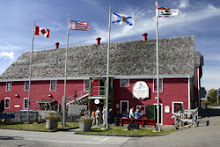Hello Everyone,
This morning, Lunenburg’s front harbour is like a pond of burnished silver, reflecting the colours of the sky, paused with an pregnant hush. Will it rain? Will it clear? We don’t know.
It is an easy thing to stand on land and look out to the ocean, wondering what the weather conditions might bring. It is an entirely different matter to be on the ocean, especially aboard a fishing vessel, and be at the mercy of the whims of nature.
Now-a-days, with computers and a multitude of ship-to-shore communications, sudden storms rarely arrive without some form of advance warning. Mariners no longer have to base their survival on the rhyming ditties of old, including:
Red sky in the morning,
Sailors take warning.
Red sky at night,
Sailor’s delight.
Sadly, the change in communication has taken place only within the span of a lifetime. The turning point for Nova Scotian schooners came with the August Gales of 1926 and 1927. Although the technology had been available before that date, fishing schooners were not equipped with receivers until after the horrific loss of life in the Gales.
Although the hurricanes hit along the shore and caused wide-spread destruction, the Lunenburg fleet was hit particularly hard. In those two years, 138 fishermen aboard six Lunenburg schooners were lost. One of the keenest felt aspects of the tragedy is that those on land knew of the approaching storms, based on weather reports. The men aboard the schooners had no such luxury and unwittingly faced a dark future.
After the 1927 Gale, the Province of Nova Scotia made arrangements to have weather signals sent via radio, from Cape Breton. The owners of the schooners were instructed to install radio receivers aboard their vessels. Those two simple acts, previously avoided because of the expense, undoubtedly saved countless lives.
Wishing you Smooth Sailing,
Heather
Subscribe to:
Post Comments (Atom)

No comments:
Post a Comment